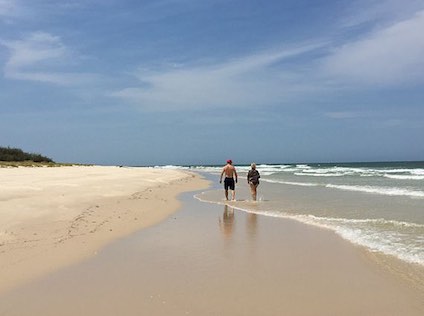
Homeowner Liza Jackson is going off the grid on Bribie island in Queensland. And she is one of many residents leaving the grid behind. With a population of 20,000 Bribie is the smallest and most northerly of three major sand islands forming the coastline sheltering the northern part of Moreton Bay, Queensland, Australia.
A survey revealed 75% of islanders are struggling to pay their bills, while 31% are sacrificing groceries to compensate.
Ms Jackson has already spent $6500 on 16 solar panels for a lean $38 quarterly saving and is working toward buying battery backups to fight the rising costs.
“I’ve lived in north West Australia where the prices are astronomical, but I’ve been gobsmacked by the prices of power in Queensland,” she said.
“With the rising costs, I’m looking at myself becoming pensioner and thinking ‘I’m not going to afford this’.
“If you believe that (prices will plateau), then you believe in the tooth fairy… there’s no limit on these private companies buying wholesale and on selling to customers.”
She’s not alone, according to the Bribie Island Neighbourhood Centre’s relief and budgeting volunteer Michael Daniell.
“(Electricity) is getting out of control… it’s increasing all the time and wages and Centrelink isn’t matching it,” he said.
“Young couples with children are the hardest… food, electricity and a roof over your head are the major priorities and sometimes it can mean going without one of them.”
Mr Daniell said he helps struggling bill payers manage their debt through widely available schemes the public often aren’t aware of.
“We do have a Home Emergency Assistance Scheme; if you’re a current concession holder we can help you claim (part of) your bill.
“My advice is, don’t ignore debt, ring up the (power) companies and work out a plan.
“They don’t know how much debt you’re in; if you just call and tell them your circumstances they can work something out.”
The state and federal governments have recently been in a war of words about the current state of electricity prices in the Sunshine State, with each party blaming the other.
“Since the Palaszczuk Government launched our Powering Queensland Plan, forward wholesale contract prices for 2018 have fallen by more than 16%,” Acting Energy Minister Curtis Pitt said.
“Between March-May this year, Queensland had the lowest wholesale prices of any state, and we remain the lowest.
“Due to the broken state of the National Electricity Market, wholesale electricity prices have increased across the board but much more in every other state between 2014-15 and 2016-17 than Queensland, which includes: 177% in South Australia, 131% in New South Wales, 119% in Victoria, 103% in Tasmania and 77% in Queensland,” Mr Pitt said.
This comes after Queensland’s wholesale electricity prices hit record highs and was the most expensive in the country in January.
Phone the Bribie Island Neighbourhood Centre on 34088440 for financial help.
Wholesale electricity rises in Australia, 2014-17
South Australia177%
NSW131%
Victoria119%
Tasmania103%
Queensland77%
